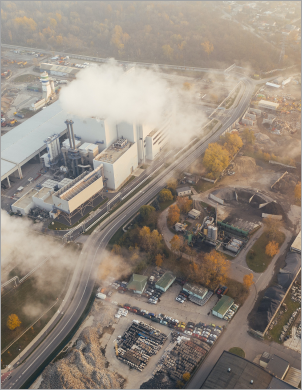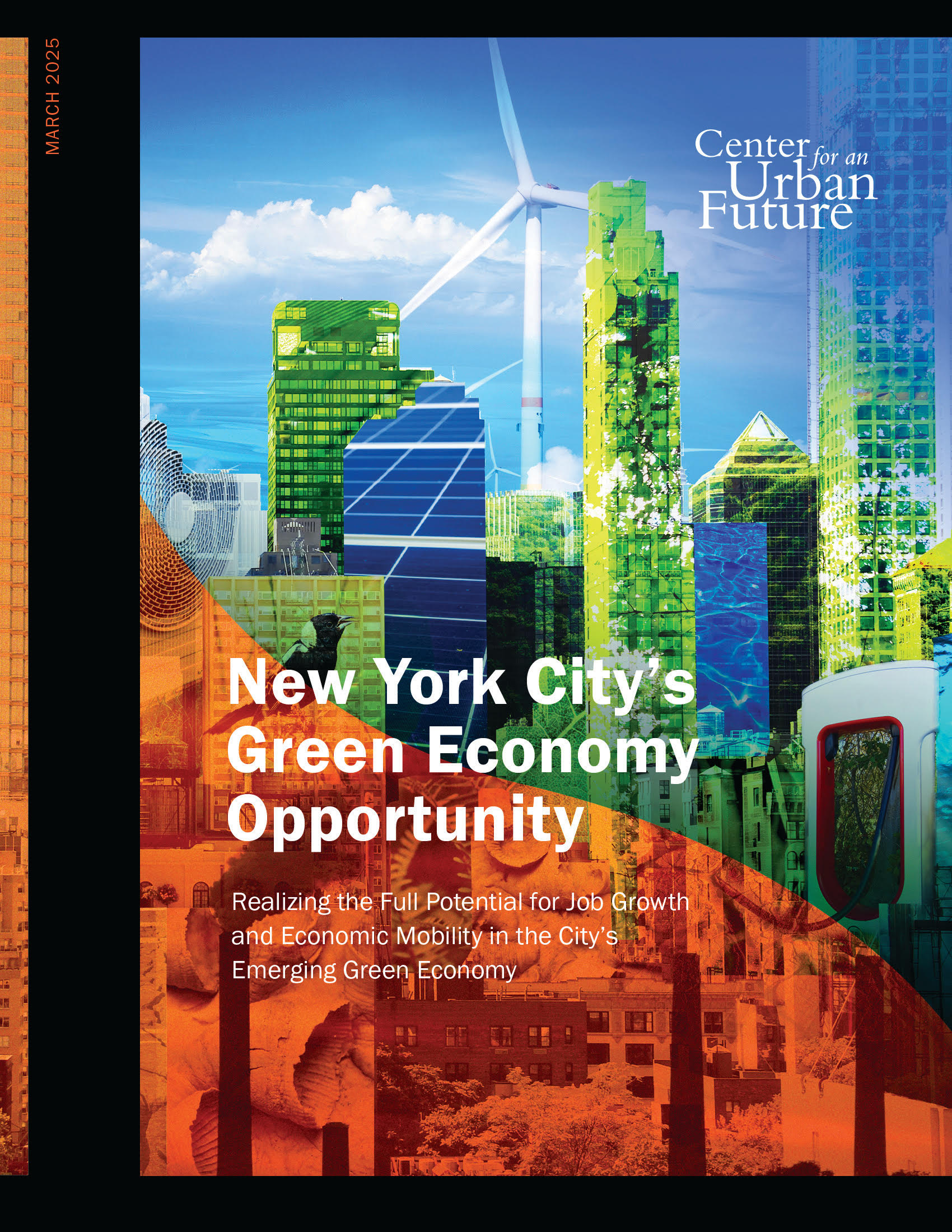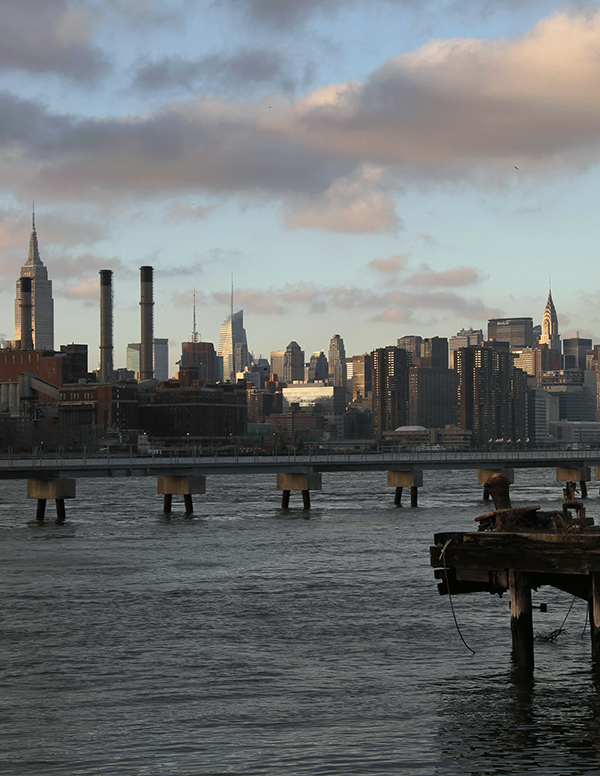As New York City's largest property owner, the City of New York will have to make swift and sustained progress in reducing greenhouse gas emissions from the buildings it operates to lessen the city's carbon footprint and tackle a major driver of climate change. A new analysis by the Center for an Urban Future reveals that while the intensity of greenhouse gas emissions from city-owned buildings has decreased 9.6 percent since 2014, eight of 25 city agencies have experienced emissions increases.1
The greatest emissions increases have been among the 117 City University of New York (CUNY) buildings included in the city's data, which registered a 15 percent rise in emissions intensity from 2014 to 2019. Achieving the city’s goal of net-zero carbon emissions by 2050, therefore, will almost certainly require a new level of investment in decarbonizing CUNY and other city agencies that are falling behind the emissions-reduction curve.
This report analyzes data on more than 1,600 city-owned buildings tracked by the New York City Department of Finance and published in its annual municipal government energy benchmarking reports. The analysis shows that while city government has made strides in reducing greenhouse gas emissions from city-owned buildings in recent years by investing in building retrofits, modernized heating and cooling systems, and energy efficiency upgrades, progress has been strikingly uneven.
In addition to the emissions increases at CUNY, seven other agencies and governmental entities posted emissions increases, including the Department of Environmental Protection (+6.8 percent across 18 buildings), the Department of Corrections (+4.6 percent across 5 buildings), the Queens Public Library (+3.5 percent across 13 buildings), and the Department of Parks and Recreation (+1.1 percent across 50 buildings). Three other agencies/offices posted emissions gains where the data is limited to just one or two buildings, including the Office of the Chief Medical Examiner (+39 percent across 2 buildings), the Department for the Aging (+25 percent at 1 building), and the Department of Housing Preservation and Development (+4 percent at 1 building).2
Of the 117 CUNY buildings analyzed, 56 percent were able to reduce emissions, but the remaining 44 percent saw emissions rise even more swiftly, driving the significant overall increase. CUNY’s community colleges’ average emissions intensity rose by 7.2 percent, while the senior colleges fared worse, registering 17.7 percent higher average emissions in 2019 than 2014.
Our analysis finds that reductions at several agencies have driven the city's overall downward trend, led by the Department of Education, which registered a 14 percent decline in emissions intensity across 981 buildings—the largest number of buildings of any agency in the dataset. Other agencies with declines outpacing the citywide average include the Administration for Children’s Services (-21 percent across 8 buildings), the Department of Homeless Services (-20 percent across 38 buildings), and NYC Health + Hospitals (-17 percent across 32 buildings). The Brooklyn Public Library also managed significant reductions (-16 percent across 28 buildings), as did the Department of Citywide Administrative Services (-16 percent across 43 buildings), and the Human Resources Administration (-14 percent across 9 buildings).
The overall decline in emissions intensity of 9.6 percent since 2014 forges a feasible path to achieving the city's goal of reducing emissions from large buildings by up to 40 percent by 2030, compared to 2005.3 However, the challenge will only grow as the city continues to experience the effects of climate change, including an increase in the number of unusually hot and cold days that drive additional energy consumption.4 To achieve this ambitious goal, Mayor Adams and other city and state officials will have to prioritize capital funding for building systems upgrades and retrofits among those agencies where emissions intensity is increasing or falling behind the citywide average decrease—especially at CUNY, which oversees the largest group of city-owned buildings to register an overall emissions increase since 2014. At a time when New York City is still down nearly 250,000 jobs from its pre-pandemic peak, a major new public investment in building decarbonization efforts can help spark much-needed new jobs while making progress on the city's economic and sustainability goals.
Key findings of this analysis include:
- Across the 117 buildings tracked in city data, CUNY registered a 15 percent increase in CO2 emissions per square foot, rising from 7.49 kg CO2e/ft2 in 2014 to 8.58 in 2019. That is the largest increase of any agency or entity with three or more buildings in the dataset.
- Eight of the 25 city agencies for which data is available saw their emissions per square foot increase from 2014 to 2019, limiting the city’s progress toward its sustainability goals.
- Average emissions also rose in buildings managed by the Department of Environmental Protection (+6.8 percent, from 18.64 in 2014 to 19.91 in 2019), the Department of Corrections (+4.6 percent, from 10.84 to 11.34), the Queens Public Library (+3.5 percent, from 8.01 to 8.28), and the Department of Parks and Recreation (+1.1 percent, from 13.60 to 13.75). The Office of the Chief Medical Examiner, Department for the Aging, and Department of Housing Preservation and Development all also saw emissions per square foot grow over this period.
- Overall, emissions were down 9.6 percent across more than 1,500 city-owned buildings for which data is available, dropping from 7.07 kg CO2e/ft2 in 2014 to 6.40 in 2019.
- A few agencies powered this progress, led by a 14 percent decline in emissions intensity across 981 buildings managed by the Department of Education—the largest number of buildings of any agency in the dataset. The steepest emissions decreases include a 21 percent decline at the Administration for Children’s Services (from 5.99 kg CO2e/ft2 in 2014 to 4.74 in 2019), a 21 percent decrease at the Department of Homeless Services (from 9.98 in 2014 to 7.96 in 2019), a 17 percent decrease at NYC Health + Hospitals (from 16.94 to 14.12), a 16 percent decrease at the Brooklyn Public Library (from 6.48 to 5.46), and a 16 percent decrease at the Department of Citywide Administrative Services (from 7.43 to 6.27).
- The Fire Department (-9.1 percent), Cultural Institutions Group (-7.8 percent), New York Public Library (-5 percent), Department of Health and Mental Hygiene (-3.1 percent), and Department of Sanitation (-2.1 percent) all registered a reduction in emissions intensity, but did so at a lower rate than the city overall, limiting the city’s overall progress.
- City-owned buildings on Staten Island registered the greatest reduction in emissions (-16.5 percent), followed by Manhattan (-11 percent), Queens (-9.4 percent), Brooklyn (-8 percent), and the Bronx (-7.4 percent). Queens, Brooklyn, and the Bronx all registered slower declines than the citywide average.
- Average emissions declined significantly in 2020, dropping 11.8 percent from 6.40 kg CO2e/ft2 in 2019 to 5.64 in 2020, as city office workers, students and teachers, and librarians switched to working and learning from home. But with most city-owned buildings reopened and New Yorkers returning in-person to city offices, schools, and libraries, emissions are almost certain to bounce back without significant new efforts to achieve further reductions through retrofits and upgrades.
CUNY Carbon Footprint (kilograms of CO2 emitted per square foot), 2014–2019
| Colleges | 2014 | 2015 | 2016 | 2017 | 2018 | 2019 | 2014-2019 Change (#) | 2014-2019 Change (%) |
|---|
| CUNY, Senior Colleges | 7.51 | 8.03 | 8.99 | 9.04 | 9.10 | 8.84 | 1.33 | 17.7% |
| CUNY, Community Colleges | 7.43 | 9.01 | 9.17 | 8.26 | 9.72 | 7.96 | 0.53 | 7.2% |
| Total CUNY | 7.49 | 8.32 | 9.04 | 8.81 | 9.29 | 8.58 | 1.09 | 14.5% |
Source: Center for an Urban Future analysis of municipal government energy benchmarking data from the NYC Department of Finance.
Municipal Building Carbon Footprint by City Agency, 2014–2019 (kg CO2e/ft2)
| Agency | # of Buildings | 2014 Emissions (kg CO2e/ft2) | 2019 Emissions
(kg CO2e/ft2) | 2014-19 Change (#) | 2014-19 Change (%) |
|---|
| City University of New York, All | 117 | 7.5 | 8.6 | 1.1 | 15% |
| Department of Environmental Protection | 18 | 18.6 | 19.9 | 1.3 | 7% |
| Department of Corrections | 5 | 10 | 11.3 | 0.5 | 5% |
| Queens Public Library | 13 | 8.0 | 8.3 | 0.3 | 3% |
| Department of Parks and Recreation | 50 | 13.6 | 13.7 | 0.1 | 1% |
| Department of Sanitation | 40 | 11.5 | 11.3 | -0.2 | -2% |
| Department of Health and Mental Hygiene | 20 | 10.7 | 10.3 | -0.3 | -3% |
| New York Public Library | 44 | 6.9 | 6.6 | -0.4 | -5% |
| Cultural Institutions Group | 27 | 8.9 | 8.2 | -0.6 | -7% |
| Fire Department of New York | 51 | 9.2 | 8.4 | -0.8 | -9% |
| New York Police Department | 89 | 10.6 | 9.4 | -1.2 | -11% |
| Human Resources Administration | 9 | 6.0 | 5.2 | -0.8 | -14% |
| Department of Education | 981 | 5.3 | 4.5 | -0.7 | -14% |
| Department of Citywide Administrative Services | 43 | 7.4 | 6.3 | -1.2 | -16% |
| Brooklyn Public Library | 28 | 6.5 | 5.5 | -1.0 | -16% |
| NYC Health + Hospitals | 32 | 16.9 | 14.1 | -2.8 | -17% |
| Department of Homeless Services | 38 | 10.0 | 8.0 | -2.0 | -20% |
| Administration for Children's Services | 8 | 6.0 | 4.7 | -1.2 | -21% |
Source: Center for an Urban Future analysis of municipal government energy benchmarking data from the NYC Department of Finance.5
Municipal Building Carbon Footprint (kg CO2e/ft2) by Borough, 2014–2019
| Borough | 2014 Emissions (kg CO2e/ft2) | 2019 Emissions (kg CO2e/ft2) | 2014-2019 Change (#) | 2014-2019 Change (%) |
|---|
| Manhattan | 8.23 | 7.32 | -0.91 | -11.0% |
| Bronx | 6.52 | 6.03 | -0.49 | -7.4% |
| Brooklyn | 6.86 | 6.31 | -0.55 | -8.0% |
| Queens | 6.80 | 6.16 | -0.64 | -9.4% |
| Staten Island | 7.00 | 5.84 | -1.15 | -16.5% |
Source: Center for an Urban Future analysis of municipal government energy benchmarking data from the NYC Department of Finance.
Endnotes
1 For this data brief, CUF analyzed municipal building carbon emissions data from the NYC Energy Benchmarking Report: https://www1.nyc.gov/site/finance/taxes/property-reports/nyc-energy-benchmarking-report.page. Because energy usage dropped precipitously in 2020 due to the pandemic—as municipal buildings shuttered and schools shifted to remote learning—we focused on data from 2014–2019 for our analysis.
2 Emissions intensity benchmarking reported in this data was not fully standardized across agencies. As a result, some agencies only have data available for a limited portfolio of their buildings. As such, this data analysis should be considered a snapshot of progress rather than a comprehensive analysis of every city-owned building.
3 Inventory of New York City Greenhouse Gas Emissions, NYC Mayor’s Office of Sustainability, https://nyc-ghg-inventory.cusp.nyu.edu/#data.
4 https://www.thecity.nyc/environment/2020/12/1/21920796/nyc-climate-progress-backslides.
5 Only agencies with five or more tracked buildings included.




